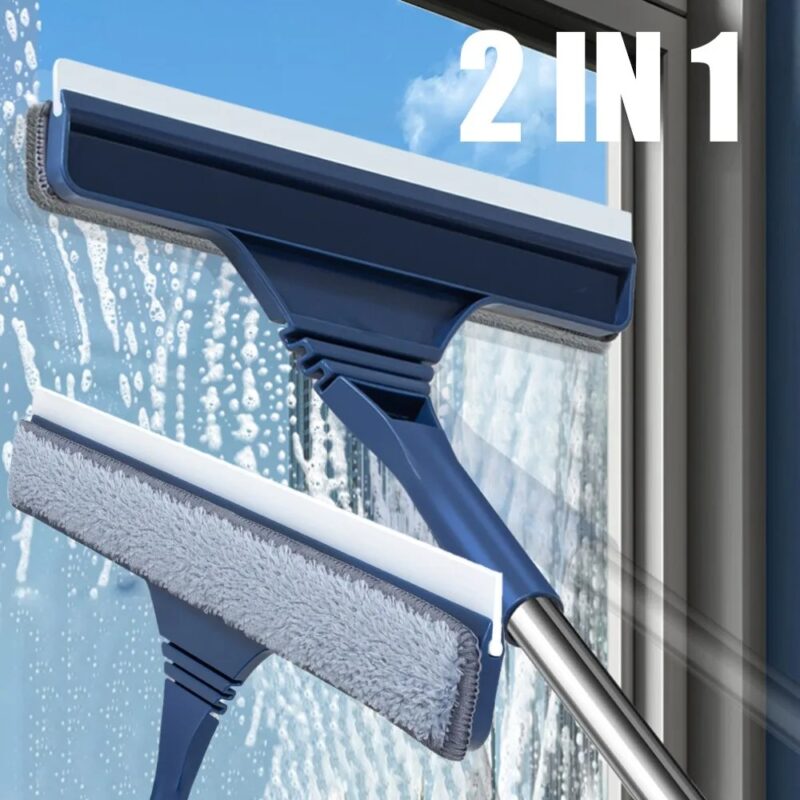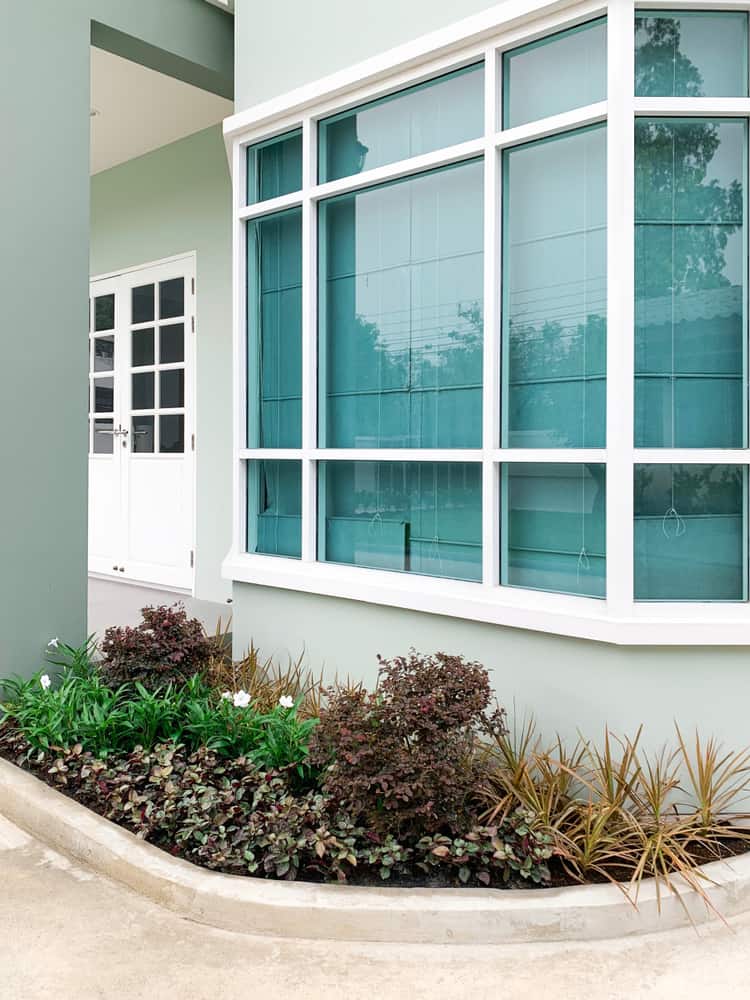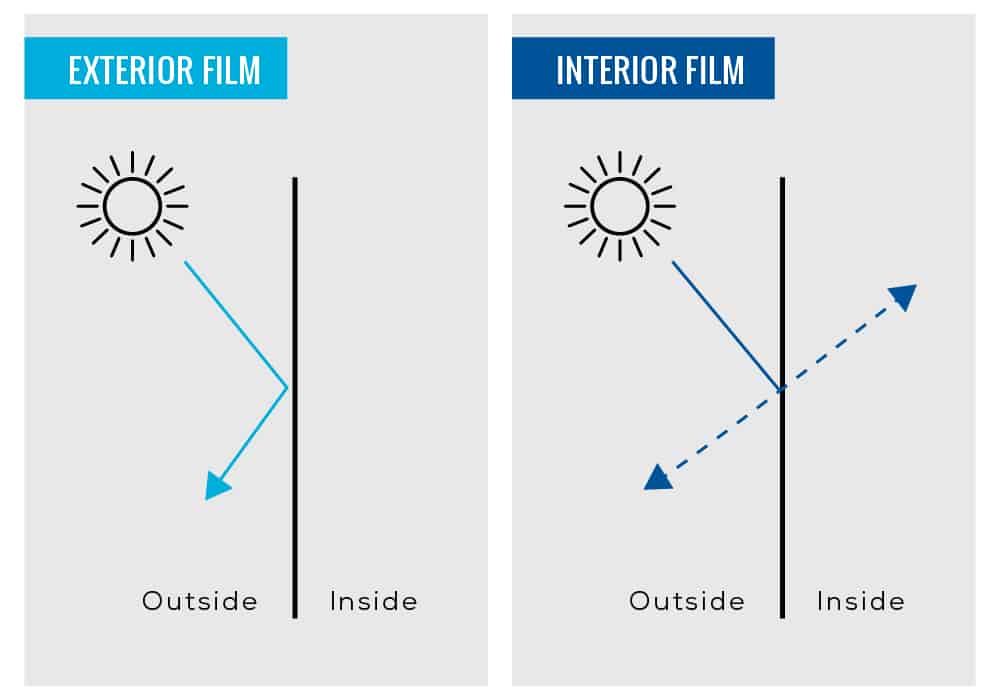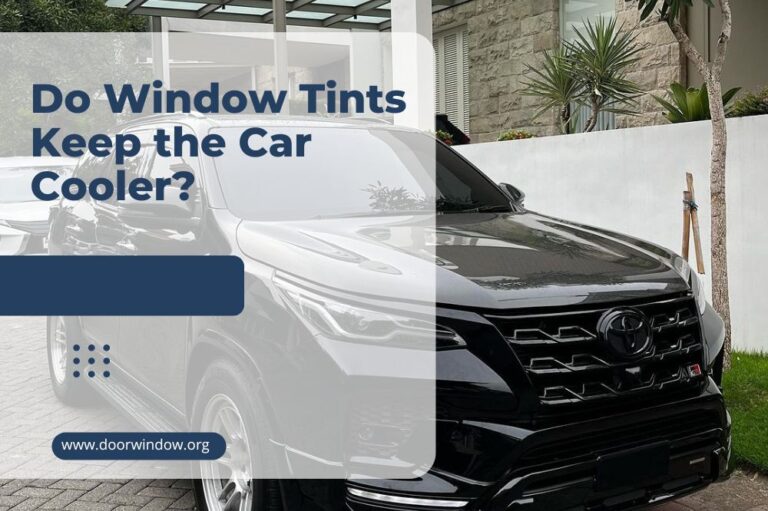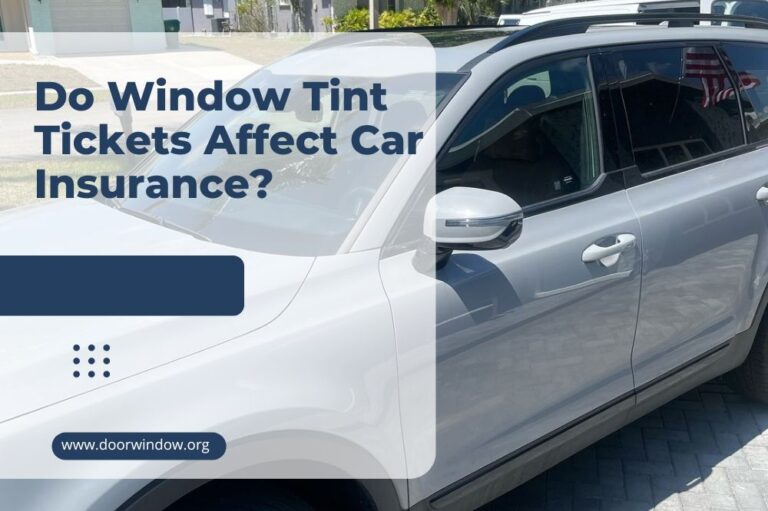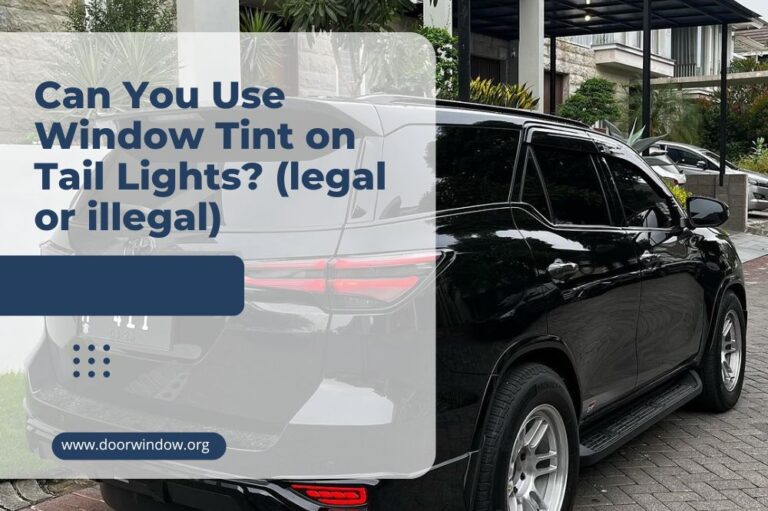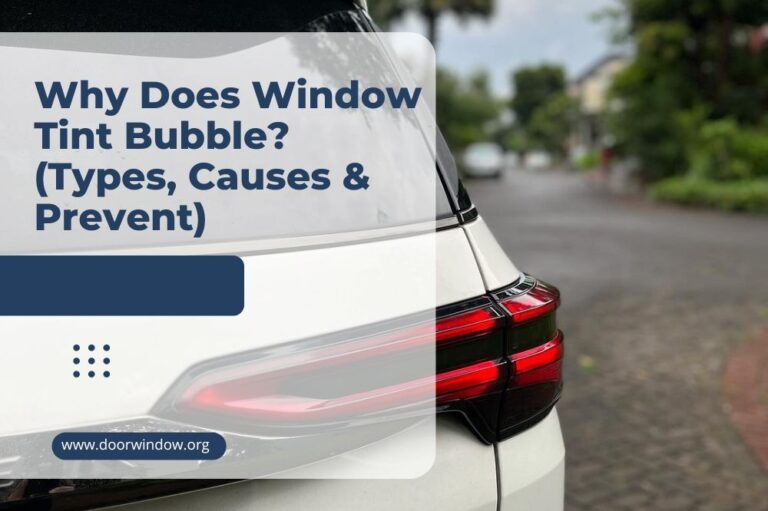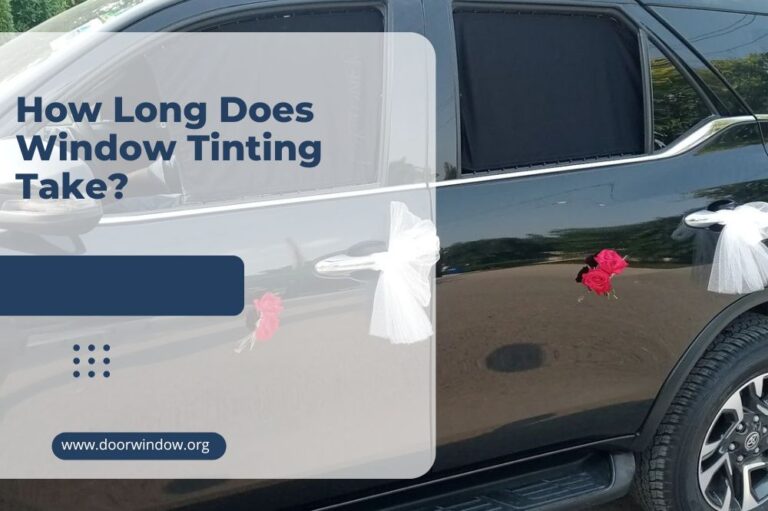Can Window Tint Go on the Outside? (Exterior vs. Interior)

Most owners install window films inside to protect them from physical damage. However, the question is can window tint go on the outside because this option has numerous benefits, including accessibility, flexibility, and hard-wearing. Plus, it rejects heat more efficiently than the interior film type and provides additional privacy.
Nowadays, tint manufacturers give their best to enhance exterior window films’ general performance, durability, and esthetics. In some cases, it is even impossible to access the windows from the inside to apply a film, so this solution is excellent, especially for office buildings. In any case, it is worth checking this option before deciding to darken your windows.
Applying Window Film Outside
For years, it was possible to install a tint only over the windows inside, but that has changed these years. Nowadays, you can install modern tints designed from multi-layered polyester materials outside and enjoy even more benefits than the inside film can provide.
Such a film has a few remarkable properties, including:
- Heat, UV, and glare control
- Privacy protection
You can apply exterior window film to numerous places for both reasons, preference and necessity. For instance, you can pick out this option when:
- It is impossible to move heavy machinery or furniture in big commercial buildings that block access to the window from the inside
- You look for additional privacy, particularly balconies with glass railings or glass walls around swimming pools
The incredible thing is that you will be protected without compromising a beautiful view. Plus, new models are different compared to the old technology that comes with the hard coat. They are designed to withstand bad external influences, including harsh weather.
The exterior window film works by reflecting sunlight before it reaches the window glass surface. You can find two window film types:
Reflective – It blocks heat and reflects sunlight, and is inexpensive. Unfortunately, this type contains metal and interferes with Wi-Fi and cellular signals.
Tinted but optically transparent – It absorbs and then redistributes heat and sunlight.
Exterior Window Film Types
Nowadays, you can pick out the same color for external window films as standard interior tints that have been available for decades. Most owners prefer natural, bronze, and silver shades as options that can fulfill their needs.
1. Exterior decorative film
The exterior application is a better option when you want to apply graphics to your window. Such a film is designed to be a temporary solution and typically lasts 5 to 7 years. It is excellent for office buildings and commercial spaces intended for business.
2. Exterior security film
This film type’s purpose is to enhance your window glass security and reduce the consequences of glass breakage. You can choose between clear undetectable, and light control versions, but both come with options to block UV rays.
Think about film shades and thickness before installing it since these features depend on your needs and home location. If you plan to apply this film to your vehicle windows, you will be safe from glass shards in the case of an accident.
3. Exterior solar window film
Window films for solar control are an excellent option that comes in two variations, with low and high reflectivity. They have numerous benefits, such as:
- Allowing natural light
- Energy saving and energy costs reduction
- Heat and UV rays reduction
- Infrared light blocking
- Providing daytime privacy
You can apply them on the outside of single and dual pane windows and laminated panels. Manufacturers typically offer a limited warranty since this product’s life expectancy is approximately 7 to 12 years.
4. Exterior anti-graffiti film
This window film type is designed to protect the exterior glass side in high-traffic areas. Its application will reduce glass replacement and repair costs if you become a victim of vandalism. Applying such a film can protect storefronts and mirrors in:
- Commercial bathrooms
- Public buildings
- Train stations
- Office buildings
Exterior Window Film Advantages
Exterior window film comes with numerous advantages, such as:
Longevity
The exterior film is a hard-wearing solution that typically lasts longer than interior tint. Nowadays, you can find different types made of advanced materials, while reputable manufacturers produce superior products and offer fantastic warranty options.
Finally, well-trained technicians install exterior window films quickly and precisely, making them a viable solution.
Accessibility
You can quickly and effortlessly access exterior window glass. Plus, its installation won’t disturb usual family daily activities inside your home.
Performance
Modern exterior window films are weatherable and perform great regardless of weather conditions. After solving the problem with longevity, manufacturers have made this option more appealing and beneficial than interior films.
Aesthetics
New exterior window film types will increase your home aesthetic and highlight landscaping elements placed around your home, like outdoor decking and pool area. Moreover, you can choose the film you like the best without many limitations. Some manufacturers offer even frosted glass films capable of applying from the outside.
Exterior vs. Interior Window Film
You can read about numerous benefits for both options, exterior and interior film applications. It depends only on you which one to choose. However, external window film seems to have a few advantages compared to the one applied inside. Let’s see.
Better heat rejection
The rule of thumb is that exterior film provides more heat rejection than tints on the window inside. Interior-applied tint draws heat and sunlight through the window glass and then redistributes it outside. In other words, light and heat regularly enter inside for a short time.
On the other hand, exterior window film absorbs and redistributes sunlight and heat before penetrating window glass, making it better for protecting your home.
Higher flexibility
The exterior film is more flexible than interior tint, which is crucial when you have curved or irregular interior surfaces like:
- Conservatory roofs
- Skylights
- Atriums installed in the house
They make window tinting installation from inside time-consuming and harder.
Durability
Exterior window film contains a scratch-resistant coating designed to protect your window from harsh weather. Be prepared that high-quality film can last for years, but inferior options require replacing as soon as it looks a bit worn.
Keeps your windows clean
Exterior films keep windows cleaner than interior tints. The secret is in a hydrophobic coating that protects the glass from dirt and watermarks.
Things to Know Before Tinting Home Windows
1. Carefully choose the film type
The first thing to do is to decide what is the purpose of window tinting in your case. If you primarily want to improve your home energy efficiency, you should pick out solar window film.
In a case of increased risk of burglary or harsh weather, the best option you have is security window film. Finally, you should choose decorative film if your only concern is beautifying your home.
2. You can’t match every film with any window type
It is impossible to apply each film type on any window glass since not all are compatible. Be aware that window films absorb heat to varying degrees. For instance, decorative and security styles block heat minimally, but they are excellent for:
- Insulating windows with two glass layers
- Basic flat (annealed) window glass
- Heat-treated window glass
If you follow instructions, the risk of glass damage is negligibly low.
Be careful with solar film and avoid it in certain situations since its higher heat absorption rate can increase the thermal stress and cause glass breaking. It is not suitable for annealed glass:
- Clear type thicker than 0.375 inches (9.5 mm)
- Clear type with a heat absorption rate of over 50%
- Tinted type thicker than 0.25 inches (6.35 mm)
- Over ten years old insulated glass with seal failures
3. Windows without low-E coating benefit from tinting
If you have older windows without energy-efficient coatings, you will see numerous benefits after having them tinted. The film will block heat and save energy, lowering your electricity bills.
4. Tinted home windows are highly economical
Applying window film is economical and will cost you $2 to $4 per 1 sq ft (0.09 m2). Since you can effortlessly install it on your own, the entire option is affordable. If you are not skillful, you should pay $5 to $8 per 1 sq ft (0.09 m2) for professional installation.
The simple math shows that tinting a 44 by 44 inches (1.1 x 1.1 m) single-window pane will cost you a modest $27 to $54. It is an average price for a DIY project, but you should set aside more money if you plan to have the job professionally done.
5. Renter-friendly options
Nowadays, you can choose decorative, solar, and safety window films available in three options:
- Permanent varieties excellent for homeowners
- Removable semi-permanent varieties
- Temporary varieties great for renters
6. Window film installation affects a window warranty
Most manufacturers invalidate window warranty after film applying. They will refuse to cover damages caused by aftermarket window film since some tint types damage the glass. Therefore, it is wise to check your warranty before tinting.
Summary
A tinted window is beneficial whether you plan to apply film to your home or car windows. Most owners use the tint inside windows, but applying them outside can be an excellent option.
Be aware that there is a difference between applying tinting glass to the inside or outside, and many experts recommend the second option as more practical and effective.

